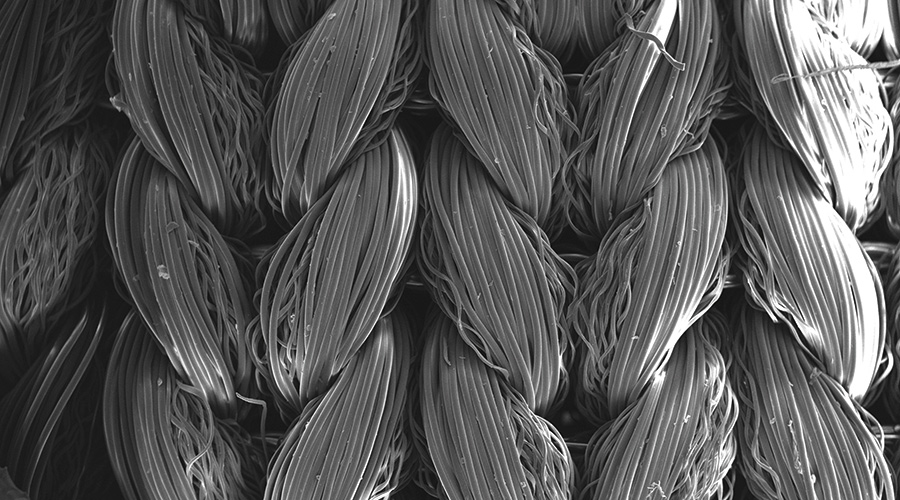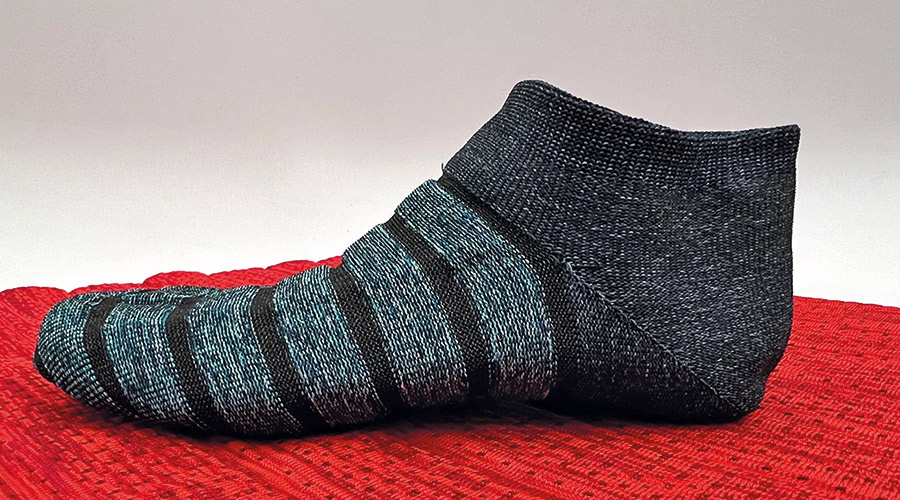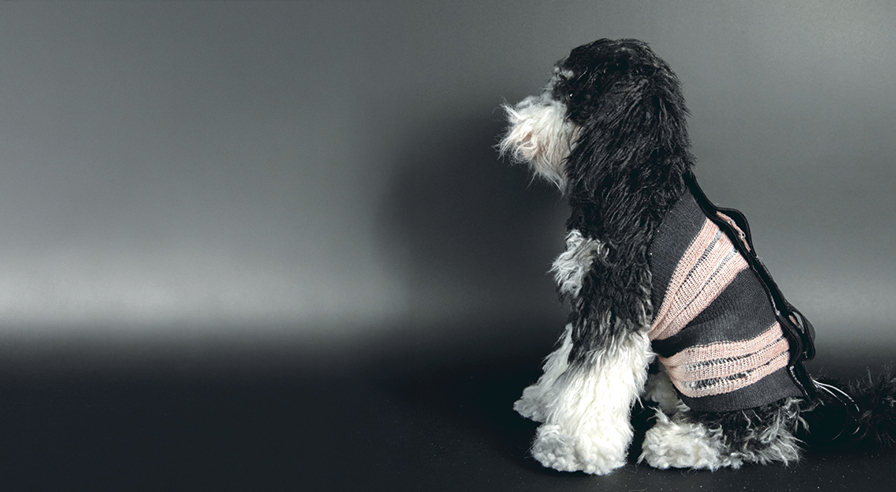Digital knitting machines and other manufacturing advances mean smart textiles are getting even smarter, as Maria Burke reports.
The global smart textiles market is booming, reaching $4.3bn in 2022 and expected to grow on average 18%/year, according to a recent Business Research Insights report [1]. Products range from wound dressings that alert wearers to infection, to wearable monitors that check vital signs and fashion garments that play music and display messages and tweets. In the area of sports performance, many firms are working on smart clothing and accessories that allow athletes to function in challenging temperatures, as well as collecting data on athlete movements. Examples include insoles for running shoes or clothing to measure muscle strength.
Since the early pioneering work in the 1990s, the manufacture of smart textiles has advanced enormously. New research is pointing to an exciting future where sensing and functions diffuse more fluidly into materials – promising even more applications. Despite recent progress, however, the functionality, dimensions and shapes of smart materials have been limited by manufacturing processes. Most efforts have focused on coating, screen-printing, embedding or attaching electronic devices to fabrics. But these approaches can be difficult to translate into large-scale manufacturing.
Digital knitting

MIT researchers were able to greatly improve the precision of pressure sensors woven into multilayered knit textiles, which they call 3DKnITS. Credit: Irmandy Wicaksono
Advances in digital fabrication and computer-aided design have revolutionised the concept of 3D knitting with computerised knitting machines. Researchers at Massachusetts Institute of Technology (MIT), US, for example, have used digital knitting machines to produce smart textiles that conform to the body so they can sense the wearer’s posture and motions by detecting several pressure points at the same time [2].
‘With digital knitting, you have this freedom to design your own patterns and also integrate sensors within the structure itself, so it becomes seamless and comfortable, and you can develop it based on the shape of your body,’ says Irmandy Wicaksono, a research assistant at MIT.
The machine weaves together layers of fabric with rows of standard and functional yarn. The final textile – ‘3DKnITS’ – consists of two layers of conductive yarn sandwiched around a piezoresistive knit, which changes resistance when squeezed. Following a pattern, the machine stitches this functional yarn throughout the textile in horizontal and vertical rows. Where the functional fibres intersect, they create a pressure sensor. However, the yarn is soft and pliable, so the layers shift and rub against each other when the wearer moves. This can be noisy and reduces the accuracy of the pressure sensors. Wicaksono’s solution was to use thermoplastic yarns that start to melt when heated above 70oC in a process called thermoforming; this slightly hardens the textile so it can hold a precise shape.
‘The thermoforming really solves the noise issue because it hardens the multilayer textile into one layer by essentially squeezing and melting the whole fabric together, which improves the accuracy,’ he says. ‘Thermoforming also allows us to create 3D forms, like a sock or shoe, that actually fit the precise size and shape of the user.’

MIT researchers have produced smart textiles that snugly conform to the body so they can sense the wearer’s posture and motions. Credit: Irmandy Wicaksono
To process the pressure sensor data, Wicaksono made a wireless circuit that scans the rows and columns on the textile and measures the resistance at each point. He then devised a system that displays pressure sensor data as a heat map. The images are fed to a machine-learning model, which is trained to detect the posture, pose, or motion of the individual based on the heat map image. The team tested the model on a smart mat and found it could classify the wearer’s activity – for example, doing push-ups – and recognise seven yoga poses with high levels of accuracy. They also used a circular knitting machine to create a smart textile shoe with 96 pressure sensing points across the entire 3D textile. They used the shoe to measure pressure exerted on different parts of the foot when the wearer kicked a ball. Wicaksono says the technique could have many applications. For example, to produce smart shoes that track the gait of someone learning to walk again after an injury, or smart textile liners to measure the pressure a prosthetic limb places on its socket.
‘It is incredible to think that the clothing we wear, an arm sleeve or a sock, can be created in ways that its 3D structure can be used for sensing,’ says Eric Berkson, assistant professor of orthopaedic surgery at Harvard Medical School, who was not involved in this research. ‘In the medical field, and in orthopaedic sports medicine specifically, this technology provides the ability to better detect and classify motion and to recognise force distribution patterns in real-world situations. This type of thinking will enhance injury prevention and detection techniques and help evaluate and direct rehabilitation.’
Scale-up
An international team led by the University of Cambridge, UK, is working on how to produce the next generation of smart textiles cost-effectively using automated processes with no limits on their size or shape. Previously, the team has demonstrated that woven displays can be made on a relatively large scale using specialised manual laboratory equipment, or in specialised microelectronics facilities. If the fibres used in smart textiles were coated with materials that can withstand stretching, the team found they could be compatible with conventional weaving processes. Using this technique, they produced a 46-inch woven demonstrator display.
Now they have taken fabrication one step further by testing their materials on industrial looms. First, they made several types of fibre devices, including energy storage devices, light-emitting diodes and transistors. These were then encapsulated with PET fibre strips and copper pads to protect against mechanical and chemical damage. The encapsulated devices were inserted into textiles – made from both synthetic and natural fibres – by automated weaving and interconnected via conductive threads using laser soldering.
Working in partnership with textile manufacturers, the researchers were able to produce test patches of smart textiles of roughly 50x50cm, although they say this can be scaled up to larger dimensions and produced in large volumes [3]. ‘These companies have well-established manufacturing lines with high throughput fibre extruders and large weaving machines that can weave a metre square of textiles automatically,’ says Sanghyo Lee of the University of Cambridge. ‘So, when we introduce the smart fibres to the process, the result is basically an electronic system that is manufactured exactly the same way other textiles are manufactured.’
Spider spinning
Meanwhile, a team from Singapore has developed a fabrication process for soft fibres inspired by how spiders spin webs. Conventional spinning methods to fabricate synthetic fibres require high pressure and energy, large volumes of chemicals, and specialised equipment. Moreover, the resulting fibres typically have limited functions. In contrast, the team at the National University of Singapore says their spider silk spinning process is highly efficient and can form strong and versatile fibres at room temperature and pressure.
Their process mimics two steps in spider silk formation. The first involves the change of a highly concentrated protein solution, known as a silk dope, into a strand of fibre. Protein concentration and interactions in the silk dope increase from synthesis to spinning. The second step – liquid-solid phase separation – involves changes in the arrangement of proteins within the dope when triggered by external factors. This helps separate the liquid portion from the silk dope, leaving the solid fibres. The team recreated the two steps and developed a new spinning process known as phase separation-enabled ambient (PSEA) spinning. The soft fibres were spun from a viscous gel solution composed of polyacrylonitrile (PAN) and silver ions (PANSion) dissolved in the solvent (DMF). This gel solution is the dope. Once the PANSion gel is pulled and exposed to air, water molecules in the air trigger the liquid portion of the gel to separate from the solid portion and can be removed.
The team showed that the PANSion gel possessed excellent strength and elasticity, while the silver ions present in the PANSion gel contributed to the electrical conductivity of the soft fibres [4]. ‘Fabrication of 1D soft fibres with seamless integration of all-round functionalities is difficult to achieve and requires complicated fabrication or multiple post-treatment processes,’ says Tan Swee Ching of the National University of Singapore. ‘This innovative method fulfils an unmet need to create a simple yet efficient spinning approach to produce functional 1D soft fibres that simultaneously possess unified mechanical and electrical functionalities.’
The team demonstrated the capabilities of the PANSion soft fibres by making an interactive gaming glove. When connected to a computer, the glove could detect human hand gestures and enable a user to play simple games. They also created a smart face mask for monitoring the wearer’s breathing – useful for conditions such as obstructive sleep apnoea. PANSion textiles could also help to detect changes in electrical signals used as a form of communication like Morse code; or to sense temperature changes and protect robots from extreme temperatures.
The process is more sustainable than current fibre-spinning methods, the team adds. PANSion fibres could be recycled by dissolving in DMF, allowing them to be converted back into a gel solution for spinning new fibres. It also consumes significantly less energy and requires smaller volumes of chemicals.
Smart fibres

Liquid crystal elastomers were used to make a remotely operated compression jacket to provide ‘hugs’ to an anxious or upset dog. Credit: Jack Forman
Research is advancing into many possible base materials for new smart textiles, but liquid crystal elastomers (LCEs) are proving particularly promising. However, researchers have struggled to produce filaments from LCEs suitable for standard textile production methods.
Now, thanks to developments in LCE fabrication with thiol-ene click chemistry, it’s possible to produce larger quantities of main-chain LCEs [5]. ‘Click’ chemistry includes a class of biocompatible reactions that are often used to join substrates to biomolecules quickly and selectively at high yields. Here it involves the organic reaction between a thiol and an alkene to form a thioether.
For example, researchers at MIT and Northeastern University, US, recently reported using thiol-ene click chemistry to produce a LCE that can be made into a programmable, actuating fibre. This fibre reversibly changes its shape in response to temperature and is compatible with standard textile manufacturing techniques [6].
When the fibre is heated, molecules in the crystal become misaligned and pull the elastomer network together, causing the material to contract, the researchers explain. The fibre returns to its original length when no longer heated. With careful mixing, the team says they can control the final properties of the fibre, such as its thickness or the temperature at which it actuates. For example, they perfected a preparation technique that creates LCE fibres that can actuate at skin-safe temperatures, making it suitable for wearable fabrics.
The team also developed a machine to spin the fibre into a continuous thread. The machine heats the LCE resin and slowly squeezes it through a nozzle. As the fibre extrudes, it is cured with UV light. In the final stage, the fibre is coated with a slippery film and cured again. The result is a strong and smooth fibre that, when dipped in powder, can pass easily into textile manufacturing machinery. The complete process takes about 24 hours. The resulting fibre can contract up to 40% without bending and be produced at relatively low cost. It can be incorporated into industrial sewing and knitting machines, as well as non-industrial processes like hand looms or manual crocheting, without process modifications.
MIT’s Jack Forman, a researcher at the MIT Media Lab, has used an industrial knitting machine to make several garments from the fibre including a sports bra that tightens when the user begins exercising and a remotely operated compression jacket for his dog to provide ‘hugs’ when she’s anxious or upset.
The fibres can also be combined with conductive thread, which acts as a heating element when electric current passes through it. In this way, the fibres actuate using electricity, which offers a user digital control over a textile’s form. For instance, a fabric could change shape based on any piece of digital information, such as readings from a heart rate sensor.
Forman says the next step is to scale up production. ‘It takes 150m of fibre to make a pair of jeans so it is a good start that we can reliably make 1km of fibre in an afternoon.’
References
- Business Research Insights
- Wicaksono, I., et al. 44th Annual International Conference of the IEEE Engineering in Medicine & Biology, Glasgow, UK, 2022
- Lee, S., et al. Science Advances, doi: 10.1126/sciadv.adf4049
- Zhang, S., et al. Nature Electronics, doi: 10.1038/s41928-023-00960-w
- Yakacki, C.M., et al. RSC Advances, doi: 10.1039/C5RA01039J
- Forman, J., et al. ACM Symposium on User Interface Software and Technology, doi: 10.1145/3586183.3606732






